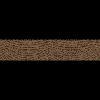File textures are bitmaps scanned from photographs, taken with a digital camera, or painted in a 2D or 3D paint package that you bring into Maya to use as a bitmap. File textures filter better than most procedural textures and can result in better image quality.
For more information see Baking illumination and color.
Considerations for creating file textures
To use a sequence of image files to create an animated file texture, the file extensions must be separated from the basename and, or the extension by periods. For examples, see Image Name.
Maya parsable, animated file textures should be of the form XXX.ext.###, where XXX is the filename, ext is an optional file extension (.sgi, .tif, .iff, and so on), and ### is the frame number.
It is also possible to use file textures of the form XXX.###.ext. We do not support XXX###.ext (without the “.” between XXX and ###), nor XXX.YYY.###.ext (but XXX_YYY.###.ext is fine).
File textures for hardware rendering
In general, when rendering with file textures, take into consideration how much space the texture takes up in screen space. Larger textures (in one or both dimensions) use a lot of memory and take longer to render because the hardware renderer must spend more time reducing their size. Try to keep textures as small as possible when rendering. This substantially decreases rendering time and memory usage and may result in better quality (fewer aliasing problems and texture crawling).
Like any other texture, you map a file texture to an attribute of a material (shader). You can map file textures as a tileable (repeating) image where the opposing edges of the texture line up.
Procedural textures are tileable by default, but if you want to tile (repeat) file textures, you must make sure edges match properly to prevent seams. To make sure edges match properly, you can use an image editing package to offset the image, then touch up light or dark areas in the offset tile.
A tileable bitmap image is one that can be broken down into smaller pieces. Tileable images load faster and easier by the renderer, saving valuable rendering time. For more information on how to reduce the load on RAM during render time by converting your textures to Block Ordered Textures (tiles), see Cache texture tiles using BOT (block ordered texture) in the Rendering guide.
Square vs. non-square bitmap images
You want your texture to fit your model perfectly, as though the texture has been painted on. You could measure the surface to which the texture is attached. However, because Maya is more efficient if it scales any non-square texture into a square texture, using a square image to begin with is recommended. If the object you are texturing is not square, for example, a lamp pole, place your texture in a black square.
